Exhibition Afterthoughts
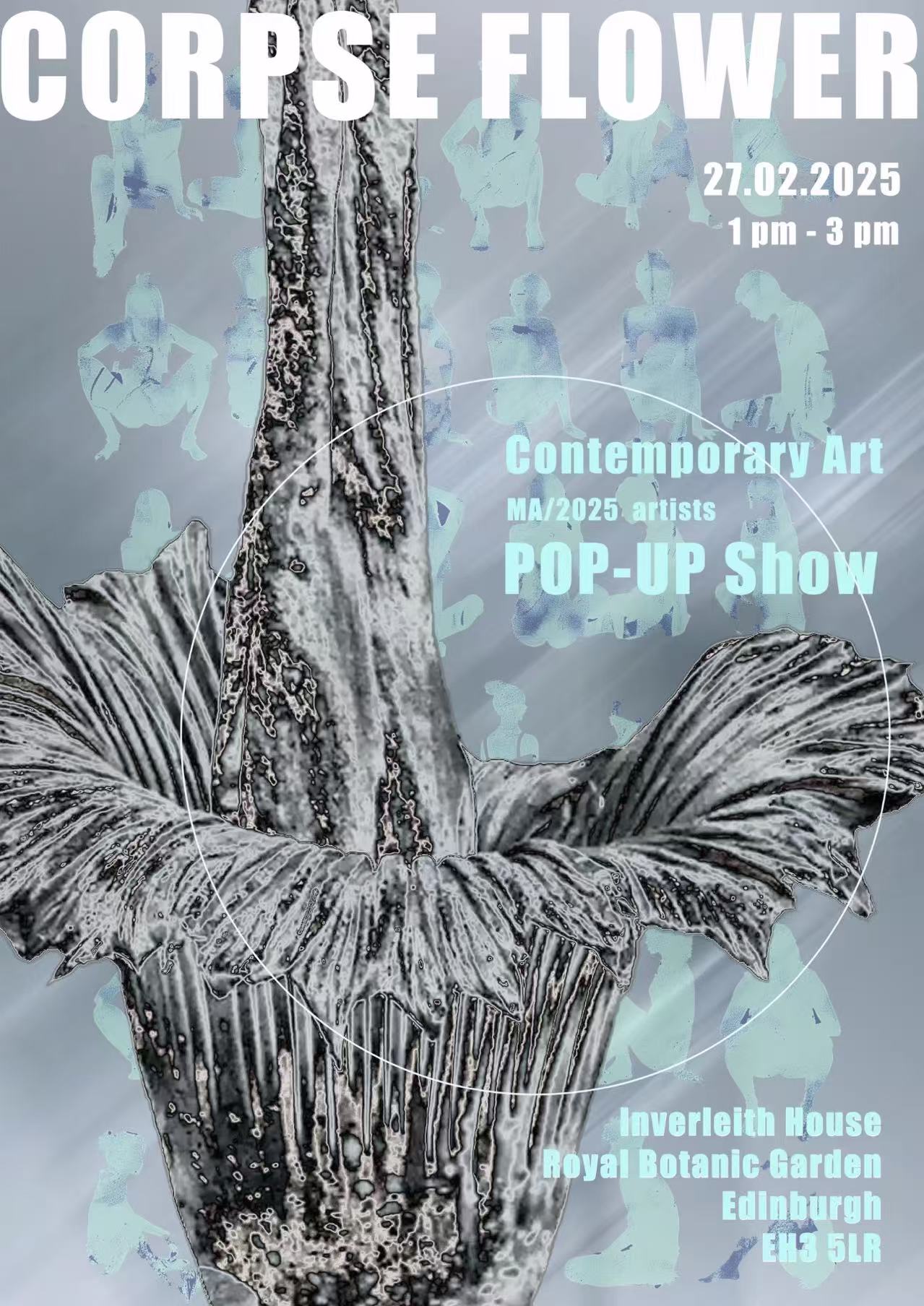
I find this exhibition very interesting as it explores the relationship between nature, life, ecology and human beings under the theme of ‘Plants’. The artworks are rich and varied, ranging from sculptures and installations to paintings and video works, presenting the growth patterns of plants, the similarities between biological structures and the human body, as well as the symbiotic relationship between man and nature. Here are my analyses of some of the works:
1.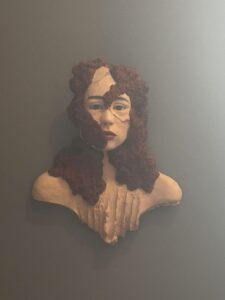

What I find interesting about this artwork is the blurring of the boundaries between man and nature. This artwork combines human and plant textures, especially the crack-like detail of the chest, which makes you think: is nature eroding the human body? Or is man growing into some new form of life? Or does it symbolise some kind of ‘return’ – that humans are part of nature? This ambiguity is particularly intriguing to me, as it is not a simple ‘human body + plant’ patchwork, but rather a deeper exploration of the nature of life. And this work can be interpreted in many ways, depending on the viewer’s perspective:
Ecological perspective: it may suggest that humans will eventually become part of nature or have to reconnect with it.
Body and self-awareness: it may explore changes in the individual body, such as growth, ageing, healing, etc.
Myth and futurism: it may also be an imagining of the future human form, similar to a sci-fi setting – ‘what would it be like if humans evolved into semi-plant life?
2.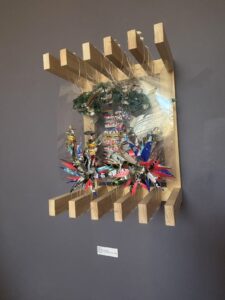

This artwork is filled with densely coiled tree roots and blood vessel-like structures, which intertwine and extend each other, looking like the root system deep in the forest as well as the circulatory system inside the human body.
This intertwined structure gives a sense of ‘symbiosis’ or ‘entanglement’, as if nature and the human body cannot be separated, but are deeply intertwined with each other. The colours are inclined to natural tones, with a sense of heaviness and time, like some kind of ancient life structure. And the composition and lines make people think of neural network, vascular system, and even mycelium network – these are all important information and energy flow systems in life.
Perhaps the artist is expressing that the relationship between humans and plants is not just superficial, but deeper and internal. Like trees, we have ‘roots’ to draw energy from, and we need to connect with each other to survive.
This also reminded me of the interdependence of ecosystems, as if the connection between humans and plants was visualised – we are not separate, but part of nature.
This intertwined structure gives a sense of ‘symbiosis’ or ‘entanglement’, as if nature and the human body cannot be separated, but are deeply intertwined with each other. The colours are inclined to natural tones, with a sense of heaviness and time, like some kind of ancient life structure. And the composition and lines make people think of neural network, vascular system, and even mycelium network – these are all important information and energy flow systems in life.
Perhaps the artist is expressing that the relationship between humans and plants is not just superficial, but deeper and internal. Like trees, we have ‘roots’ to draw energy from, and we need to connect with each other to survive.
This also reminded me of the interdependence of ecosystems, as if the connection between humans and plants was visualised – we are not separate, but part of nature.
3.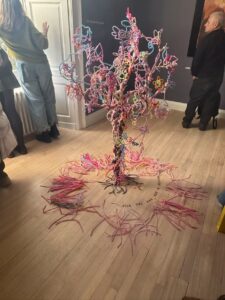

This is an installation consisting of pink ‘branches’ or ‘veins’ that resemble a tree full of exotic flowers, as well as the internal neural network or circulatory system of the human body.
Placed in the centre of the exhibition space, the work gives a strong sense of life.
It is both a dreamy plant and an externalisation of the body’s internal tissues, blurring the boundaries between nature and the body.
Placed in the centre of the exhibition space, the work gives a strong sense of life.
It is both a dreamy plant and an externalisation of the body’s internal tissues, blurring the boundaries between nature and the body.
4.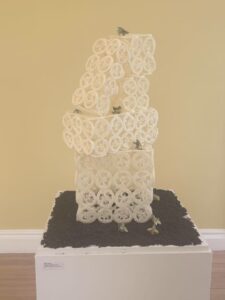

This piece is a sculpture of many white, web-like structures stacked into a form that resembles a skeleton or biological tissue.
It looks like a cellular structure, coral, or even human tissue, but it also has a sense of the growth of a plant vine.
This organic structure reminds me of the ‘commonality of biological structures and plants’ – whether it is the human skeleton or the root system of plants, they all follow a certain growth pattern.
It looks like a cellular structure, coral, or even human tissue, but it also has a sense of the growth of a plant vine.
This organic structure reminds me of the ‘commonality of biological structures and plants’ – whether it is the human skeleton or the root system of plants, they all follow a certain growth pattern.




Presentation- Your slides and presentation were well thought out, coherent, and professional. Only slightly did you go over the allocated time. I was pleased to see that you took on board and re-considered some of the feedback your peers and myself gave you from previous weeks-primarily about rethinking and or linking your topic more explicitly to contemporary art practice. On a general note your curatorial project idea needs to be narrowed down even further. I suggest that you focus on one out of the three topics and or attempt to combine the 1st and 2nd topic. Considering the work of the artist Xiaoxuan Chen showcases that you are engaging in independent research. Keep up the good work and try to investigate more emerging contemporary artists. Something I thought could be of interest to you is this symposium that took place in January, 2025 at ifk on Entangled Colonialisms of Europe and Asia: Multimodal Approaches to Decentering Eurocentrism (https://www.ifk.ac.at/blog-detail/entangled-colonialisms-of-europe-and-asia-multimodal-approaches-to-decentering-eurocentrism.html ). The topic is not exactly similar to your own curatorial proposal but does include other artists and scholars that are currently exploring Asian ethnology. The duration you propose for a 6-12 week exhibition is quite a long time and costly (consider the cost of venue hire, including the install/de-install of work, staff wages to support the running of the exhibition, etc). I would highly recommend that you reconsider this timeframe. The Project Space in Fruitmarket Gallery could potentially be an appropriate space for the exhibition but occupying the entire gallery is not feasible for an emerging curator. An idea is to visit alternative spaces in Edinburgh and Glasgow, perhaps like Dovecot Studios, Ricefield Chinese Arts and Culture Centre in Scotland or Garnethill Multicultural Centre.
Blog- Some evidence of engaging with the collective; it was insightful to read the short statements you wrote for a manifesto. Now the next step is to meet with the rest of The Sleepwalkers outside of class time and discuss, exchange ideas about your collective. The written feedback you provided for your two peers is constructive, informative and kind. I would have liked to see creative materials featured in your blog post, even if that was a reference to an artist or exhibition format you could link with your comments. The last blog post you have published titled ‘Exhibition Afterthoughts’ includes a good balance between critical reflection and contextual materials. My only suggestion is that you include the location, artist names and title/date of the exhibition in a clear and coherent format. Where did you see this exhibition? How many artists in total were included? What was the actual title? Remember to always clearly reference your research.